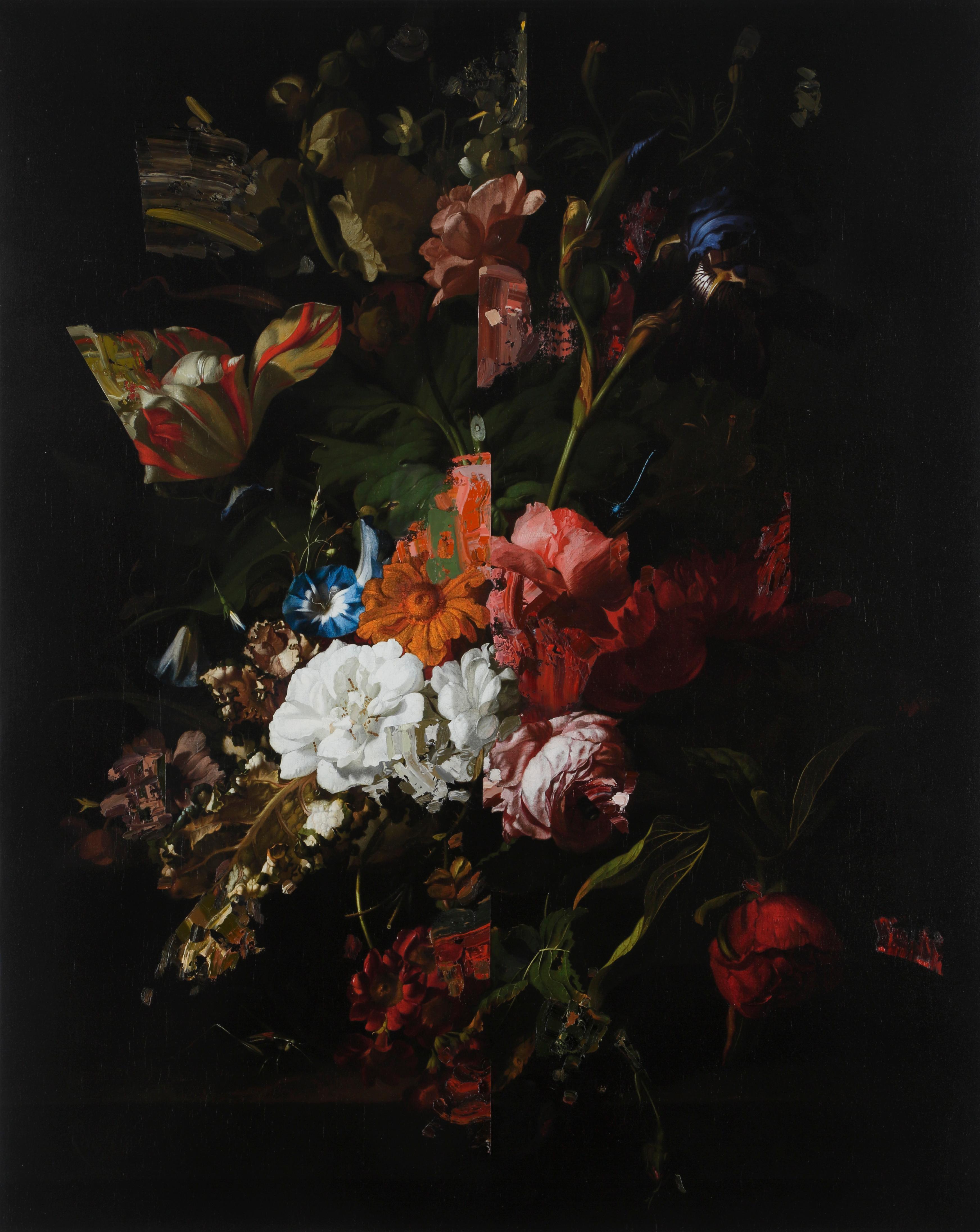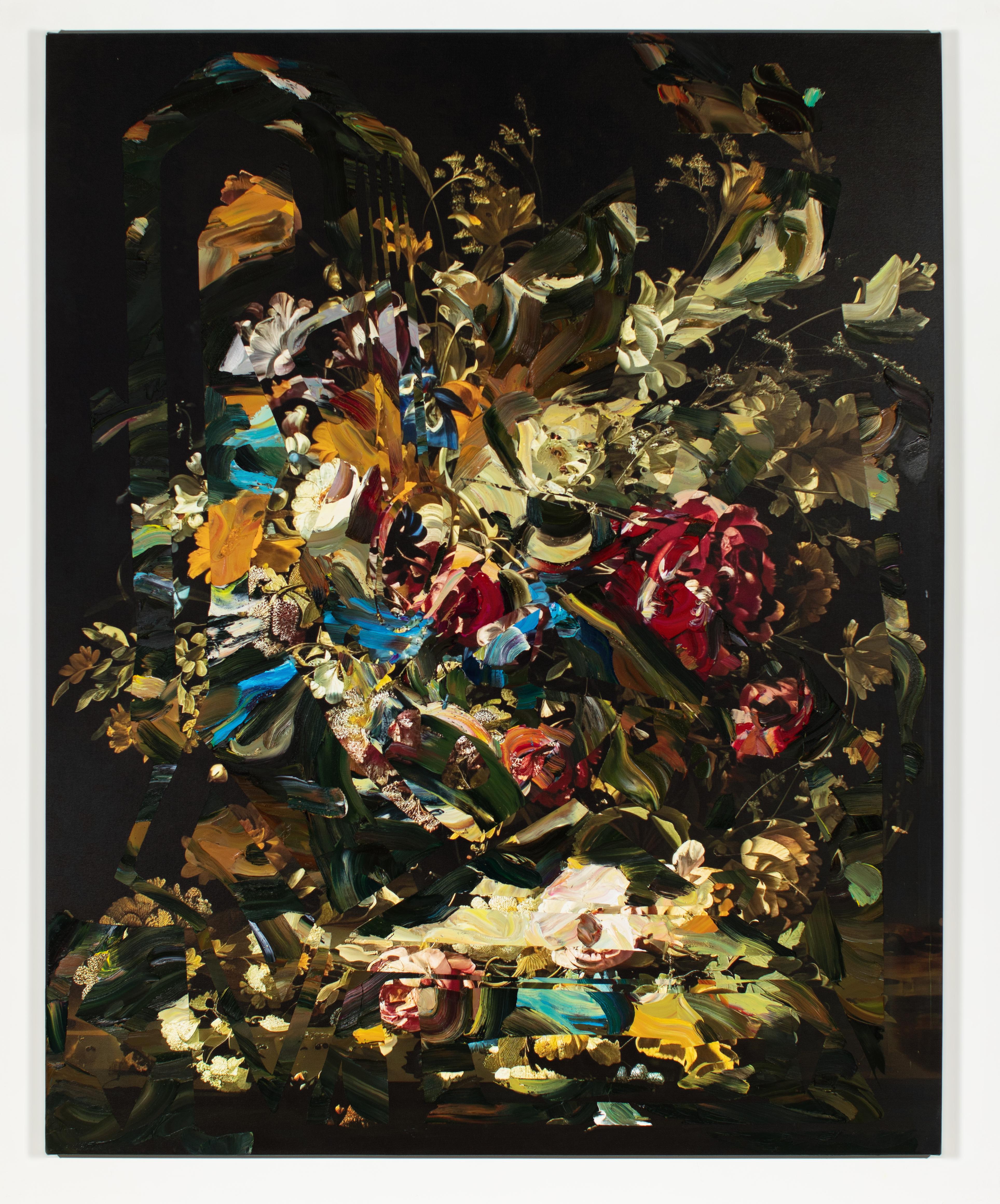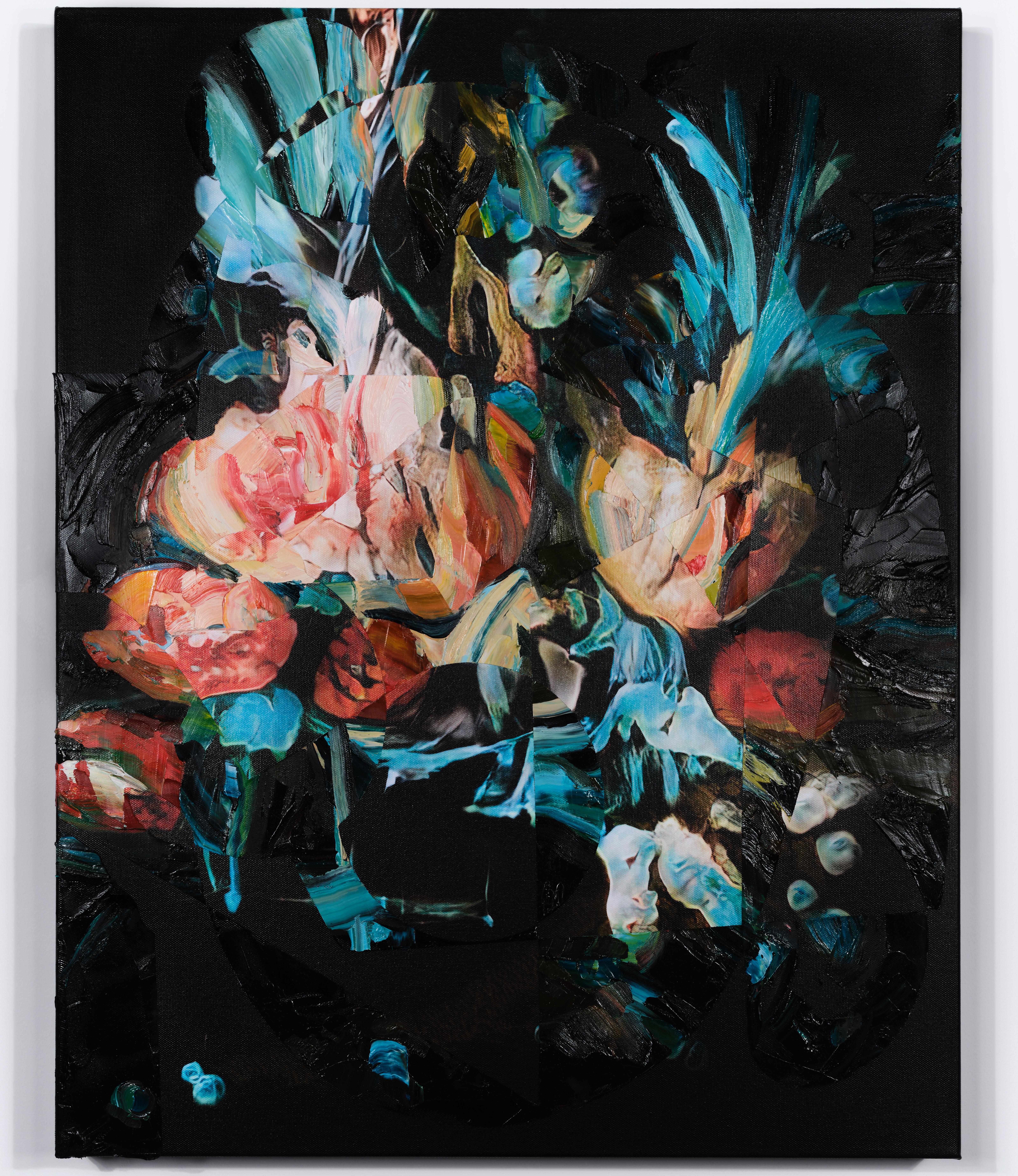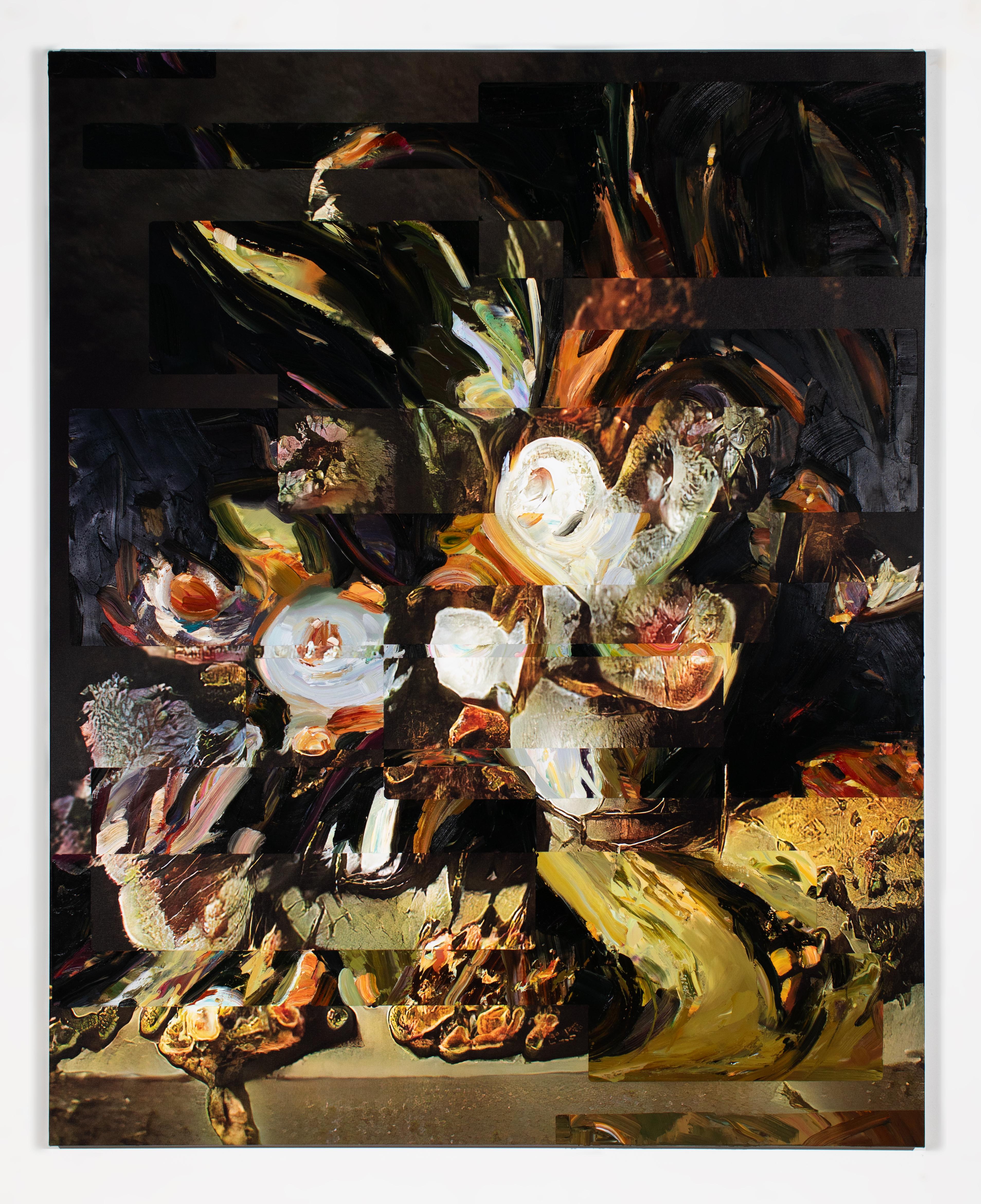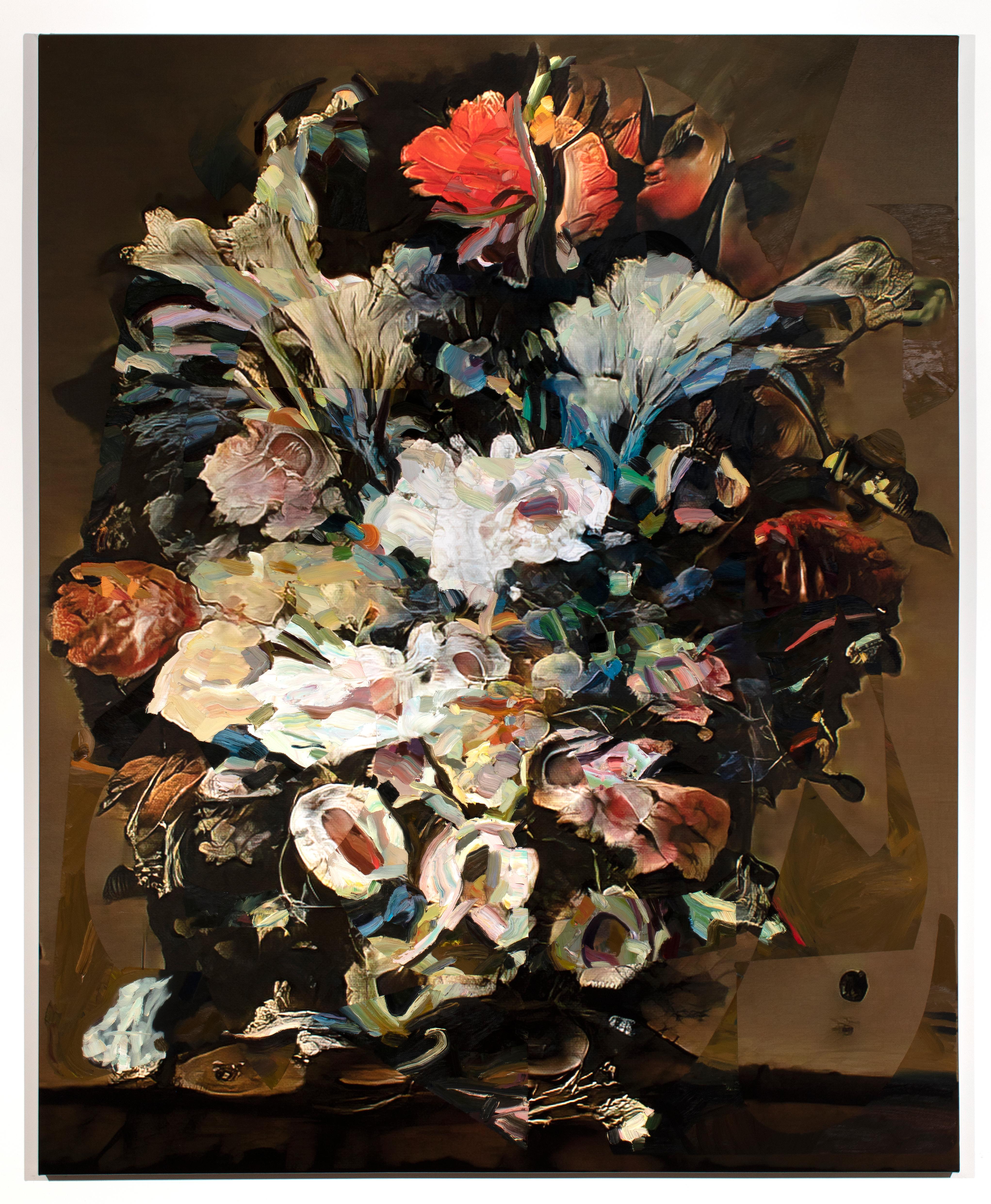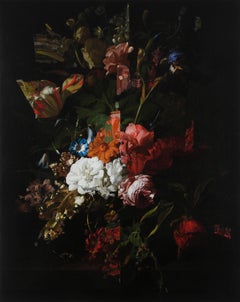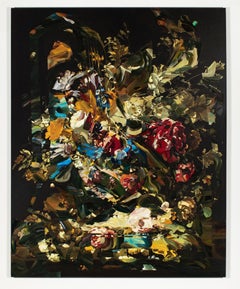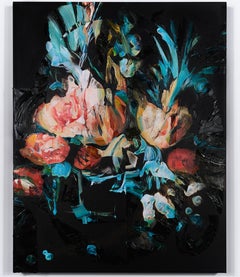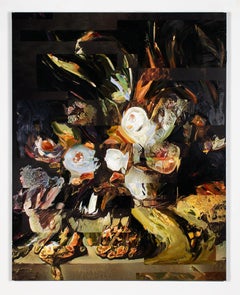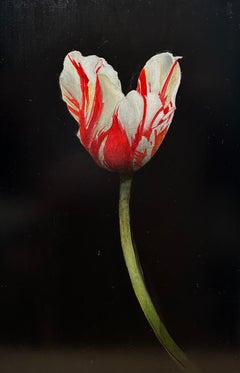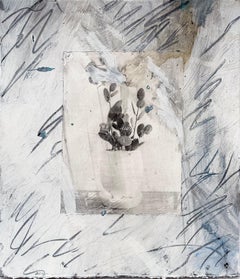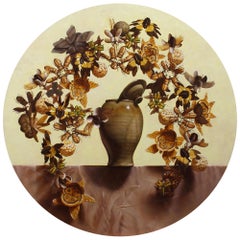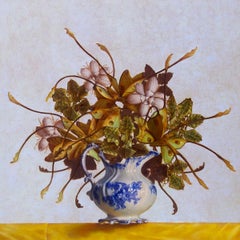Want more images or videos?
Request additional images or videos from the seller
1 of 11
Tiffany Calvert#3282019
2019
$15,500
£11,767.53
€13,485.23
CA$22,000.20
A$23,996.66
CHF 12,606.06
MX$290,310.33
NOK 157,705.90
SEK 148,905.76
DKK 100,657.99
About the Item
This painting is based on Rachel Ruysch’s, Vase of Flowers, 1700. The painting contains an example of the Dutch tulip most prized during Tulipomania: Semper Augustus. Striping is caused by a virus that infects the bulb - “The virus also weakens the bulb and retards the plant's propagation through offset growths; as it progresses through each generation the bulb grows stunted and weak. Eventually, it has no strength to flower, and either breaks apart or withers away, ending the genetic line. For this reason the most famous examples of tulips from color-broken bulbs – the Semper Augustus and the Viceroy – no longer exist.”
- Wikipedia
There is a parallel between a virus infecting the bulb and creating aberrations in its appearance (making it more rare and prized) and the aberrations I create using code altering software to create “glitches.”
As an artist, TIFFANY CALVERT applies contemporary painting techniques to historical imagery. Her recent work uses the seventeenth-century Dutch floral still life as a springboard for exploring the shifting nature of human perception. The traditional Dutch still-life often contains an abundance of visual information for the viewer to process: texture, color, sheen, and finish. Widely popular and highly prized among collectors, these painted floral arrangements were meticulously detailed compositions, whether lavish or simple, and many featured insects and animals hidden among the foliage. The paintings on display here are oil paintings on printed reproductions of a work by Dutch artist P. W. Windtraken. Calvert has intervened by matching paint to Windtraken’s original color palette, camouflaging it within the picture. Other techniques such as gridding, fragmentation, and image reversal serve to obstruct and interrupt the viewer’s perception of the image. Like a digital “glitch” or a scrambled transmission, Calvert generates paintings that are suspended in a moment, simultaneously on the verge of disintegration or cohesion. Tiffany Calvert is an artist-in-residence at the Speed Art Museum for 2018-2019, studying works in the permanent collection with Erika Holmquist-Wall, Chief Curator and Mary and Barry Bingham, Sr.
Tiffany Calvert's work has been shown internationally including Lawrimore Project in Seattle, E.TAY Gallery in New York, and Cadogan Contemporary in London. She has been awarded residencies at the ArtOmi International Arts Center and Djerassi Resident Artists Program, and funding from the Great Meadows Foundation. She has been nominated for a Joan Mitchell Painters and Sculptors Grant, and in 2010 received a Pollock-Krasner Foundation Grant. Calvert uses traditional and emerging media to investigate the mutable nature of perception and the effect of media on the substantiation of the image.
She is currently Assistant Professor of Art at the Hite Art Institute, University of Louisville and artist-in-residence at the Speed Art Museum for 2018-2019.
- Creator:
- Creation Year:2019
- Dimensions:Height: 60 in (152.4 cm)Width: 48 in (121.92 cm)
- Medium:
- Movement & Style:
- Period:
- Condition:
- Gallery Location:New Orleans, LA
- Reference Number:1stDibs: LU10525720552
About the Seller
5.0
Vetted Professional Seller
Every seller passes strict standards for authenticity and reliability
Established in 1998
1stDibs seller since 2015
174 sales on 1stDibs
Typical response time: <1 hour
- ShippingRetrieving quote...Shipping from: New Orleans, LA
- Return Policy
Authenticity Guarantee
In the unlikely event there’s an issue with an item’s authenticity, contact us within 1 year for a full refund. DetailsMoney-Back Guarantee
If your item is not as described, is damaged in transit, or does not arrive, contact us within 7 days for a full refund. Details24-Hour Cancellation
You have a 24-hour grace period in which to reconsider your purchase, with no questions asked.Vetted Professional Sellers
Our world-class sellers must adhere to strict standards for service and quality, maintaining the integrity of our listings.Price-Match Guarantee
If you find that a seller listed the same item for a lower price elsewhere, we’ll match it.Trusted Global Delivery
Our best-in-class carrier network provides specialized shipping options worldwide, including custom delivery.More From This Seller
View All#327
By Tiffany Calvert
Located in New Orleans, LA
This painting is based on Rachel Ruysch’s, Vase of Flowers, 1700. The painting contains an example of the Dutch tulip most prized during Tulipomania: Semper Augustus...
Category
21st Century and Contemporary Contemporary Still-life Paintings
Materials
Canvas, Oil, Inkjet
$15,500
#430
By Tiffany Calvert
Located in New Orleans, LA
Calvert’s current paintings investigate the relationship between digital media and the reception and perception of images, and utilizes diverse technologies such as fresco, 3D modeling, AI and data manipulation through code. She is especially interested in the evolution of pictorial space. Today we view our screens and the world they occupy as a shallowly layered space of overlapping desktop windows. The picture plane has tilted up again from the flatbed to float in front of our eyes. Calvert’s paintings in turn depict an intermediate space, where the verticality of the still life paintings cohabitate with these digital panes.
Dutch floral still life paintings encapsulate multiple concerns. Their subjects were botanical fantasies, emblems of an economic mirage that has contemporary corollaries. Most important to Calvert’s pictorial concerns, they depict ephemeral things in shallow and diagrammatic space - they are all foreground. They contain an abundance of visual information in overwhelming density, creating an allover resolution; a visual field that is equivalent to digital noise. By making painterly interventions into reproductions, Calvert attempts to dissolve the layer between the resolution of the source image and abstraction of the painted mark.
⎯⎯⎯⎯⎯
Tiffany Calvert has exhibited her work in the US and abroad including Lawrimore Project in Seattle, E.TAY Gallery in New York, the Speed Museum in Louisville and Cadogan Contemporary in London. Residencies include the Djerassi Resident Artists Program, I-Park, and ArtOmi International Arts Center where she received a Geraldine R. Dodge Fellowship. Calvert has received grants from the Great Meadows Foundation and the Pollock-Krasner Foundation. Her work was recently profiled by critic John Yau in the online journal Hyperallergic. Her curatorial projects include “Some Abstraction Occurs” at 65GRAND Gallery in Chicago and “Magic” at Mercer College (featuring work by Chris Martin, Karla Knight, and Sarah Peters...
Category
21st Century and Contemporary Contemporary Still-life Paintings
Materials
Canvas, Oil, Inkjet
$15,500
#409
By Tiffany Calvert
Located in New Orleans, LA
Calvert’s current paintings investigate the relationship between digital media and the reception and perception of images, and utilizes diverse technologies such as fresco, 3D modeling, AI and data manipulation through code. She is especially interested in the evolution of pictorial space. Today we view our screens and the world they occupy as a shallowly layered space of overlapping desktop windows. The picture plane has tilted up again from the flatbed to float in front of our eyes. Calvert’s paintings in turn depict an intermediate space, where the verticality of the still life paintings cohabitate with these digital panes.
Dutch floral still life...
Category
21st Century and Contemporary Contemporary Still-life Paintings
Materials
Canvas, Oil, Inkjet
#446
By Tiffany Calvert
Located in New Orleans, LA
Calvert’s current paintings investigate the relationship between digital media and the reception and perception of images, and utilizes diverse technologies such as fresco, 3D modeling, AI and data manipulation through code. She is especially interested in the evolution of pictorial space. Today we view our screens and the world they occupy as a shallowly layered space of overlapping desktop windows. The picture plane has tilted up again from the flatbed to float in front of our eyes. Calvert’s paintings in turn depict an intermediate space, where the verticality of the still life paintings cohabitate with these digital panes.
Dutch floral still life paintings encapsulate multiple concerns. Their subjects were botanical fantasies, emblems of an economic mirage that has contemporary corollaries. Most important to Calvert’s pictorial concerns, they depict ephemeral things in shallow and diagrammatic space - they are all foreground. They contain an abundance of visual information in overwhelming density, creating an allover resolution; a visual field that is equivalent to digital noise. By making painterly interventions into reproductions, Calvert attempts to dissolve the layer between the resolution of the source image and abstraction of the painted mark.
⎯⎯⎯⎯⎯
Tiffany Calvert has exhibited her work in the US and abroad including Lawrimore Project in Seattle, E.TAY Gallery in New York, the Speed Museum in Louisville and Cadogan Contemporary in London. Residencies include the Djerassi Resident Artists Program, I-Park, and ArtOmi International Arts Center where she received a Geraldine R. Dodge Fellowship. Calvert has received grants from the Great Meadows Foundation and the Pollock-Krasner Foundation. Her work was recently profiled by critic John Yau in the online journal Hyperallergic. Her curatorial projects include “Some Abstraction Occurs” at 65GRAND Gallery in Chicago and “Magic” at Mercer College (featuring work by Chris Martin, Karla Knight...
Category
21st Century and Contemporary Contemporary Still-life Paintings
Materials
Canvas, Oil, Inkjet
$15,500
#402
By Tiffany Calvert
Located in New Orleans, LA
As an artist, TIFFANY CALVERT applies contemporary painting techniques to historical imagery. Her recent work uses the seventeenth-century Dutch floral still life as a springboard fo...
Category
21st Century and Contemporary Contemporary Still-life Paintings
Materials
Canvas, Oil, Inkjet
#414
By Tiffany Calvert
Located in New Orleans, LA
Calvert’s current paintings investigate the relationship between digital media and the reception and perception of images, and utilizes diverse technologies such as fresco, 3D modeling, AI and data manipulation through code. She is especially interested in the evolution of pictorial space. Today we view our screens and the world they occupy as a shallowly layered space of overlapping desktop windows. The picture plane has tilted up again from the flatbed to float in front of our eyes. Calvert’s paintings in turn depict an intermediate space, where the verticality of the still life paintings cohabitate with these digital panes.
Dutch floral still life paintings encapsulate multiple concerns. Their subjects were botanical fantasies, emblems of an economic mirage that has contemporary corollaries. Most important to Calvert’s pictorial concerns, they depict ephemeral things in shallow and diagrammatic space - they are all foreground. They contain an abundance of visual information in overwhelming density, creating an allover resolution; a visual field that is equivalent to digital noise. By making painterly interventions into reproductions, Calvert attempts to dissolve the layer between the resolution of the source image and abstraction of the painted mark.
⎯⎯⎯⎯⎯
Tiffany Calvert has exhibited her work in the US and abroad including Lawrimore Project in Seattle, E.TAY Gallery in New York, the Speed Museum in Louisville and Cadogan Contemporary in London. Residencies include the Djerassi Resident Artists Program, I-Park, and ArtOmi International Arts Center where she received a Geraldine R. Dodge Fellowship. Calvert has received grants from the Great Meadows Foundation and the Pollock-Krasner Foundation. Her work was recently profiled by critic John Yau in the online journal Hyperallergic. Her curatorial projects include “Some Abstraction Occurs” at 65GRAND Gallery in Chicago and “Magic” at Mercer College (featuring work by Chris Martin, Karla Knight, and Sarah Peters...
Category
21st Century and Contemporary Contemporary Still-life Paintings
Materials
Canvas, Oil, Inkjet
$20,000
You May Also Like
Untitled
By Michael Gregory
Located in San Francisco, CA
Michael Gregory was born in 1955 in Los Angeles, CA and received his BFA from the San Francisco Art Institute in 1980. Previously living and working in Bolinas, California, Gregory h...
Category
2010s Still-life Paintings
Materials
Oil, Panel
Still Life 032
Located in New York, NY
Acrylic, coffee, ink, pumic, soft pastel, transfer on paper
Category
2010s Contemporary Still-life Paintings
Materials
Paper, Coffee, Pastel, Ink, Acrylic
Arrangement XIX
By Zane York
Located in Chicago, IL
Zane York coaxes and cajoles with a bit of humor which belies a deeper sensitivity. His eye-catching subjects never fail to cause a double-take. In our age of nearly constant visual ...
Category
21st Century and Contemporary Contemporary Still-life Paintings
Materials
Copper
Arrangement XVIII
By Zane York
Located in Chicago, IL
Zane York coaxes and cajoles with a bit of humor which belies a deeper sensitivity. His eye-catching subjects never fail to cause a double-take. In our age of nearly constant visual ...
Category
21st Century and Contemporary Contemporary Still-life Paintings
Materials
Copper
Still Life 008
Located in New York, NY
Acrylic, soft pastel, graphite, coffee, india ink, transfer on paper
Category
2010s Contemporary Still-life Paintings
Materials
Acrylic, Graphite, Paper, Coffee, Pastel, India Ink
Still Life 024
Located in New York, NY
Acrylic, coffee, ink, pumic, soft pastel, transfer on paper
Category
2010s Contemporary Still-life Paintings
Materials
Acrylic, Paper, Coffee, Pastel, Ink
